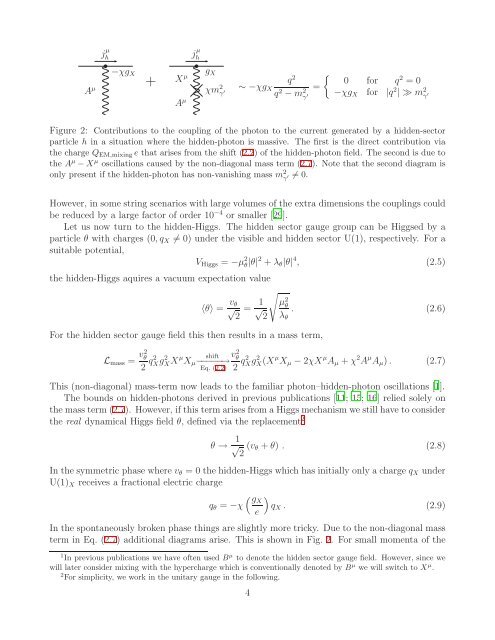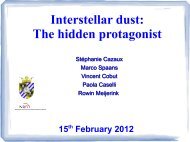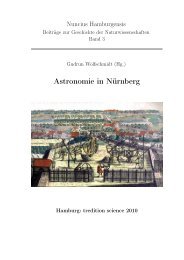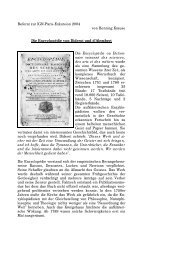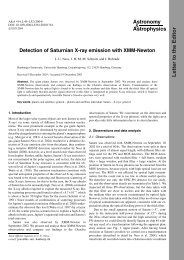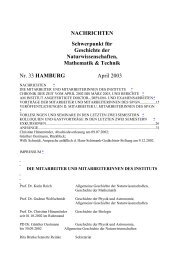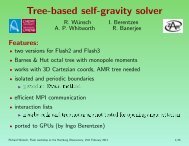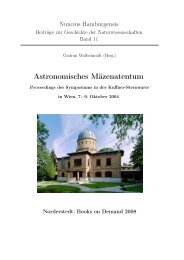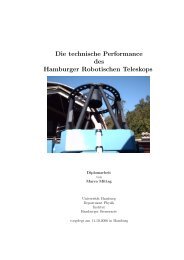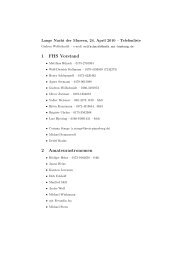Probing Hidden Sector Photons through the Higgs Window
Probing Hidden Sector Photons through the Higgs Window
Probing Hidden Sector Photons through the Higgs Window
You also want an ePaper? Increase the reach of your titles
YUMPU automatically turns print PDFs into web optimized ePapers that Google loves.
j µ h<br />
−χg X<br />
+<br />
A µ<br />
j µ h<br />
g X<br />
X µ {<br />
q 2 0 for q<br />
χm 2 ∼ −χg X =<br />
2 = 0<br />
γ ′ q 2 − m 2 −χg<br />
γ ′ X for |q 2 | ≫ m 2 γ ′<br />
A µ<br />
Figure 2: Contributions to <strong>the</strong> coupling of <strong>the</strong> photon to <strong>the</strong> current generated by a hidden-sector<br />
particle h in a situation where <strong>the</strong> hidden-photon is massive. The first is <strong>the</strong> direct contribution via<br />
<strong>the</strong> charge Q EM,mixing e that arises from <strong>the</strong> shift (2.2) of <strong>the</strong> hidden-photon field. The second is due to<br />
<strong>the</strong> A µ − X µ oscillations caused by <strong>the</strong> non-diagonal mass term (2.7). Note that <strong>the</strong> second diagram is<br />
only present if <strong>the</strong> hidden-photon has non-vanishing mass m 2 γ ′ ≠ 0.<br />
However, in some string scenarios with large volumes of <strong>the</strong> extra dimensions <strong>the</strong> couplings could<br />
be reduced by a large factor of order 10 −4 or smaller [29].<br />
Let us now turn to <strong>the</strong> hidden-<strong>Higgs</strong>. The hidden sector gauge group can be <strong>Higgs</strong>ed by a<br />
particle θ with charges (0, q X ≠ 0) under <strong>the</strong> visible and hidden sector U(1), respectively. For a<br />
suitable potential,<br />
V <strong>Higgs</strong> = −µ 2 θ |θ|2 + λ θ |θ| 4 , (2.5)<br />
<strong>the</strong> hidden-<strong>Higgs</strong> aquires a vacuum expectation value<br />
For <strong>the</strong> hidden sector gauge field this <strong>the</strong>n results in a mass term,<br />
〈θ〉 = v θ<br />
√<br />
2<br />
= 1 √<br />
2<br />
√µ 2 θ<br />
λ θ<br />
. (2.6)<br />
L mass = v2 θ<br />
2 q2 X g2 X Xµ shift vθ<br />
2 X µ −−−−−→<br />
Eq. (2.2) 2 q2 X g2 X (Xµ X µ − 2χX µ A µ + χ 2 A µ A µ ) . (2.7)<br />
This (non-diagonal) mass-term now leads to <strong>the</strong> familiar photon–hidden-photon oscillations [1].<br />
The bounds on hidden-photons derived in previous publications [11; 15; 16] relied solely on<br />
<strong>the</strong> mass term (2.7). However, if this term arises from a <strong>Higgs</strong> mechanism we still have to consider<br />
<strong>the</strong> real dynamical <strong>Higgs</strong> field θ, defined via <strong>the</strong> replacement 2<br />
θ → 1 √<br />
2<br />
(v θ + θ) . (2.8)<br />
In <strong>the</strong> symmetric phase where v θ = 0 <strong>the</strong> hidden-<strong>Higgs</strong> which has initially only a charge q X under<br />
U(1) X receives a fractional electric charge<br />
( gX<br />
)<br />
q θ = −χ q X . (2.9)<br />
e<br />
In <strong>the</strong> spontaneously broken phase things are slightly more tricky. Due to <strong>the</strong> non-diagonal mass<br />
term in Eq. (2.7) additional diagrams arise. This is shown in Fig. 2. For small momenta of <strong>the</strong><br />
1 In previous publications we have often used B µ to denote <strong>the</strong> hidden sector gauge field. However, since we<br />
will later consider mixing with <strong>the</strong> hypercharge which is conventionally denoted by B µ we will switch to X µ .<br />
2 For simplicity, we work in <strong>the</strong> unitary gauge in <strong>the</strong> following.<br />
4


